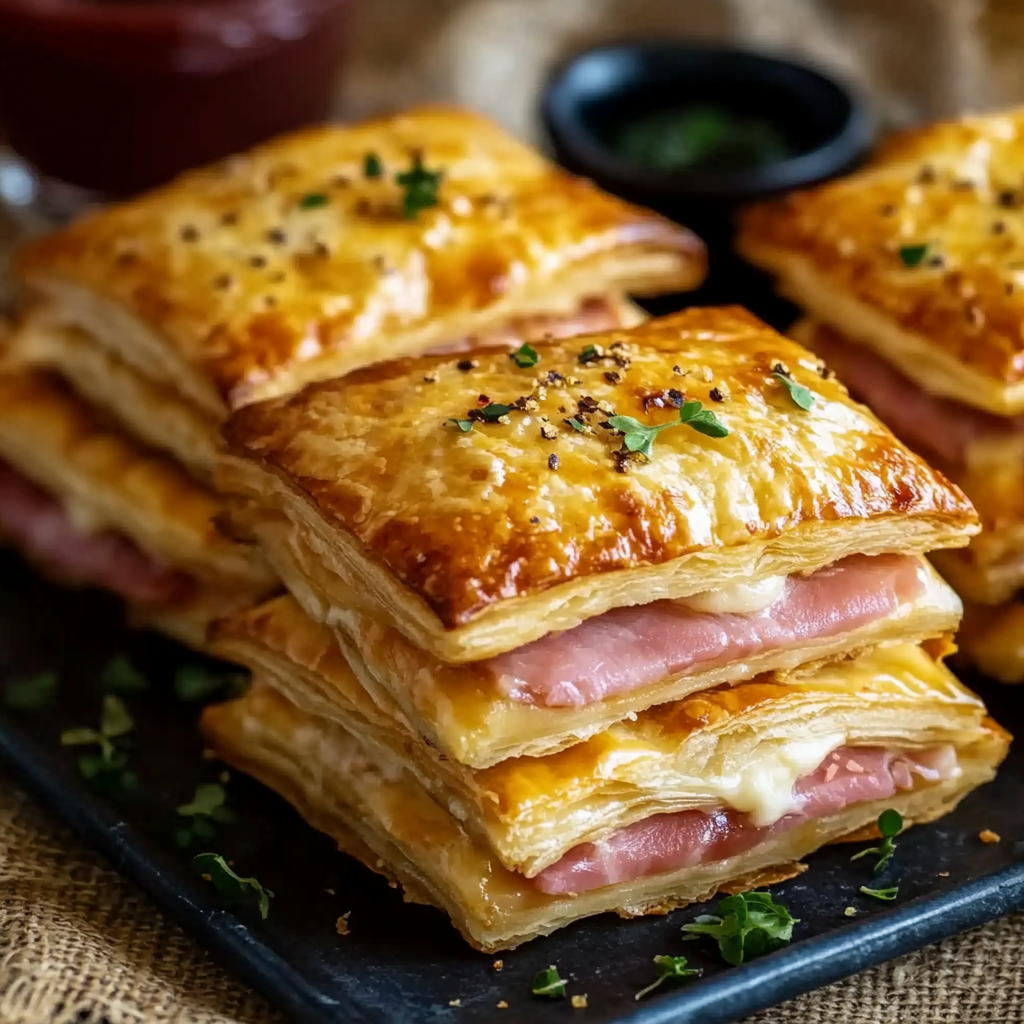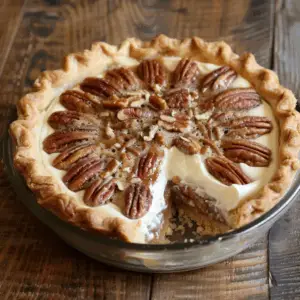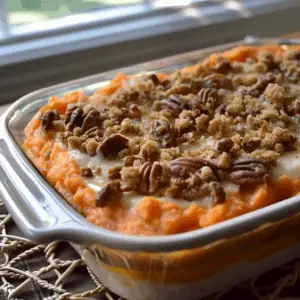When it comes to creating a quick and satisfying meal, ham and cheese puff pastry pockets are the perfect solution. These delicious pockets combine the rich flavors of savory ham and creamy cheddar cheese encased in a buttery, flaky puff pastry. Their simple preparation and mouthwatering taste make them an ideal choice for breakfast, brunch, or even a late-night snack.
Puff pastry, a light and airy dough made by layering butter and dough through repeated rolling and folding, has long been a staple in many kitchens. According to Wikipedia, puff pastry dates back centuries and remains one of the most beloved bases for savory and sweet dishes. Whether you’re hosting a brunch or need a quick grab-and-go breakfast, these pockets bring gourmet flavor with minimal effort.
For more creative ways to style your breakfast, explore some Breakfast Pastry Ideas that incorporate diverse flavors and presentation techniques to elevate your morning table.
Why You’ll Love This Recipe
There are countless reasons to fall in love with ham and cheese puff pastry pockets. First, they are incredibly easy to prepare with just a few ingredients, making them a reliable option for busy mornings. The combination of flaky puff pastry and savory fillings creates a contrast in texture and flavor that is truly irresistible.
Additionally, puff pastry is highly versatile. According to this Easy Puff Pastry Recipes collection, it serves as a blank canvas for both sweet and savory creations. If you’re exploring other quick pastry dishes, understanding basic Baking techniques can open up even more possibilities.
The Popularity of Puff Pastry in Breakfast Dishes
Puff pastry has become a cornerstone of modern breakfast cuisine due to its versatility and ease of use. From croissants to savory pockets, its light and flaky texture enhances both sweet and savory dishes. Its roots are deeply tied to European culinary traditions, particularly French baking, as detailed on Wikipedia’s page about Puff Pastry.
Today, many breakfast menus feature puff pastry as a base for creative and indulgent recipes. Exploring more brunch food inspiration can help you discover unique variations; for example, check this curated collection of ideas on Pinterest.
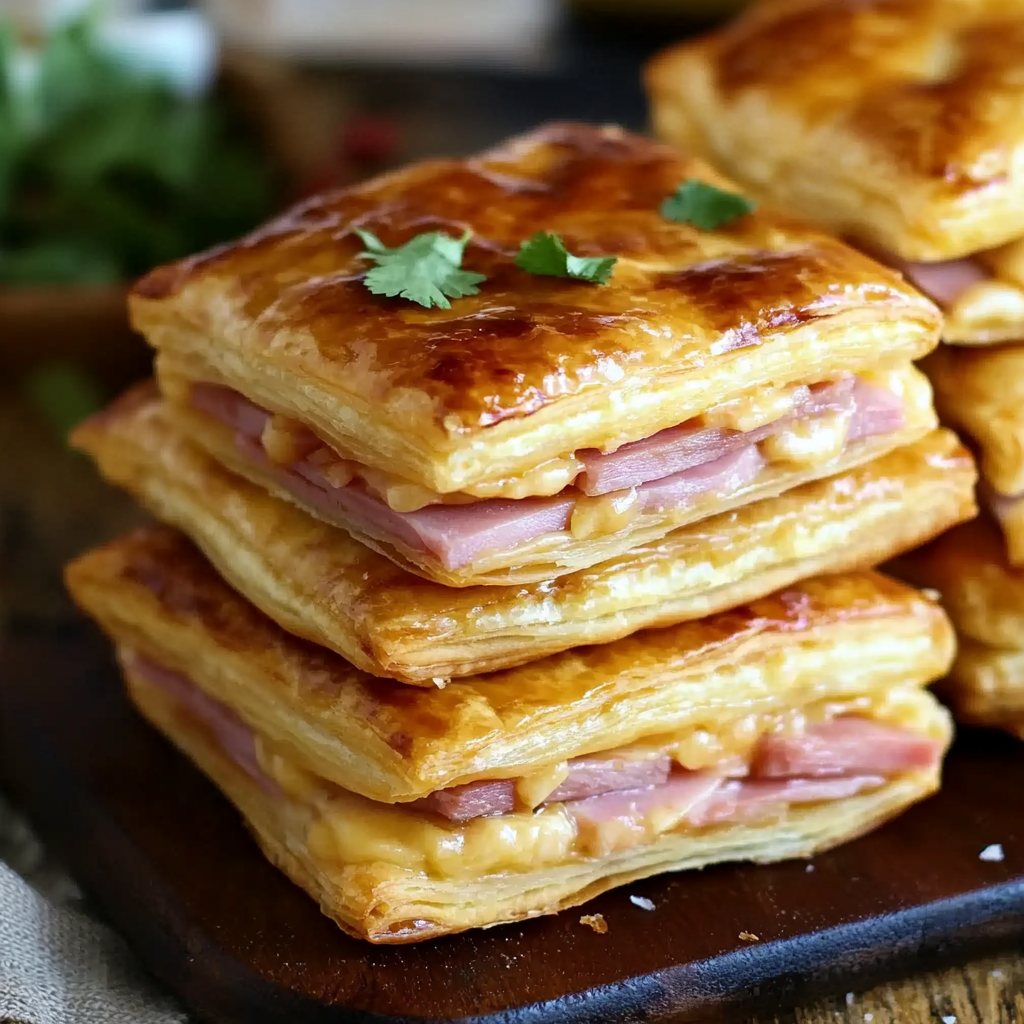
What Makes a Good Breakfast Pastry Platter
A thoughtfully arranged breakfast pastry platter should deliver a balance of flavors, textures, and visual appeal. Including a mix of savory and sweet pastries ensures that everyone finds something they enjoy. Ham and cheese puff pastry pockets are a savory favorite that pairs well with sweeter items like fruit danishes and croissants.
Presentation also matters. Incorporating colorful fruits, dips, and spreads adds variety and elevates the overall look. For tips on styling an attractive platter, explore these Breakfast Platter Presentation ideas that demonstrate how to layer items artfully.
Choosing the right accompaniments, like fresh fruit and artisan cheeses, creates a luxurious experience. Understanding the Types of Cheese available can help you offer complementary flavors that match your puff pastry pockets perfectly, making the platter unforgettable.
The Ultimate Ham and Cheese Puff Pastry Pockets Recipe
Ingredients You’ll Need
Creating ham and cheese puff pastry pockets requires just a handful of basic but high-impact ingredients. Using high-quality items enhances both flavor and texture, making your pastries stand out.
Here’s what you’ll need:
-
1 sheet puff pastry, thawed
-
4 slices chicken ham (or your preferred deli meat)
-
4 slices cheddar cheese
-
1 egg, beaten (for egg wash)
-
1 tablespoon Dijon mustard (optional, for extra flavor)
-
Flour (for dusting the surface)
Selecting a good ham, such as those mentioned in Ham (food), ensures a rich, savory bite. For cheese, cheddar offers a perfect melty texture, as outlined on Cheddar Cheese. You can swap it for Swiss or Gruyère for different flavor profiles.
Always use fresh, high-quality ingredients to maintain the best taste and presentation.
Step-by-Step Instructions
Preheat your oven to 400°F (200°C) and line a baking sheet with parchment paper. Allow your sheet of puff pastry to thaw if it is frozen. Lightly dust a clean work surface with flour and gently roll the puff pastry to smooth out any creases and even out the thickness.
Cut the pastry into four equal squares. If desired, spread a thin layer of Dijon mustard over one side of each square for a sharp, tangy flavor. Place a slice of chicken ham and a slice of cheddar cheese onto one half of each pastry square.
The filling should be placed neatly to avoid overstuffing, which can cause leakage during baking. According to baking guides like Baking Tips for Beginners, keeping fillings proportionate to pastry ensures even cooking and crispness.
Fold the pastry over the fillings to form either a rectangle or a triangle, depending on your preference.
Step-by-Step Instructions
Once folded, use a fork to press down the edges tightly, sealing the pockets completely. This prevents any cheese or juices from seeping out during baking.
Next, brush the tops of each pocket with a beaten egg. This step is crucial for achieving a beautiful golden brown finish. Position the pastries on the prepared baking sheet, ensuring they are spaced apart to allow for expansion.
Bake the pockets in the preheated oven for 15–18 minutes, or until they are puffed and golden. Be careful not to overbake, as puff pastry can quickly go from perfectly golden to burnt.
Allow the pastries to cool slightly before serving. If you’re preparing for a brunch event, find additional brunch food inspiration for side dishes here.
These homemade ham and cheese puff pastry pockets are guaranteed to become a favorite addition to your breakfast menu.
Tips for Perfect Puff Pastry Pockets
Mastering the art of making ham and cheese puff pastry pockets requires a few helpful techniques. Here are some expert tips:
-
Always thaw the puff pastry thoroughly but keep it cold to ensure maximum puffiness.
-
Prevent sogginess by using a light hand with moist ingredients like mustard.
-
Seal the edges well with a fork to lock in the fillings and avoid leaks.
-
Brush with an egg wash for a shiny, golden finish.
-
Bake on parchment paper to avoid sticking and promote even browning.
Understanding the fundamentals of baking can significantly enhance your pastry results. Visit Baking Tips for Beginners for more foundational advice. If you’re experimenting with different fillings, explore an Easy Puff Pastry Recipes collection for new ideas
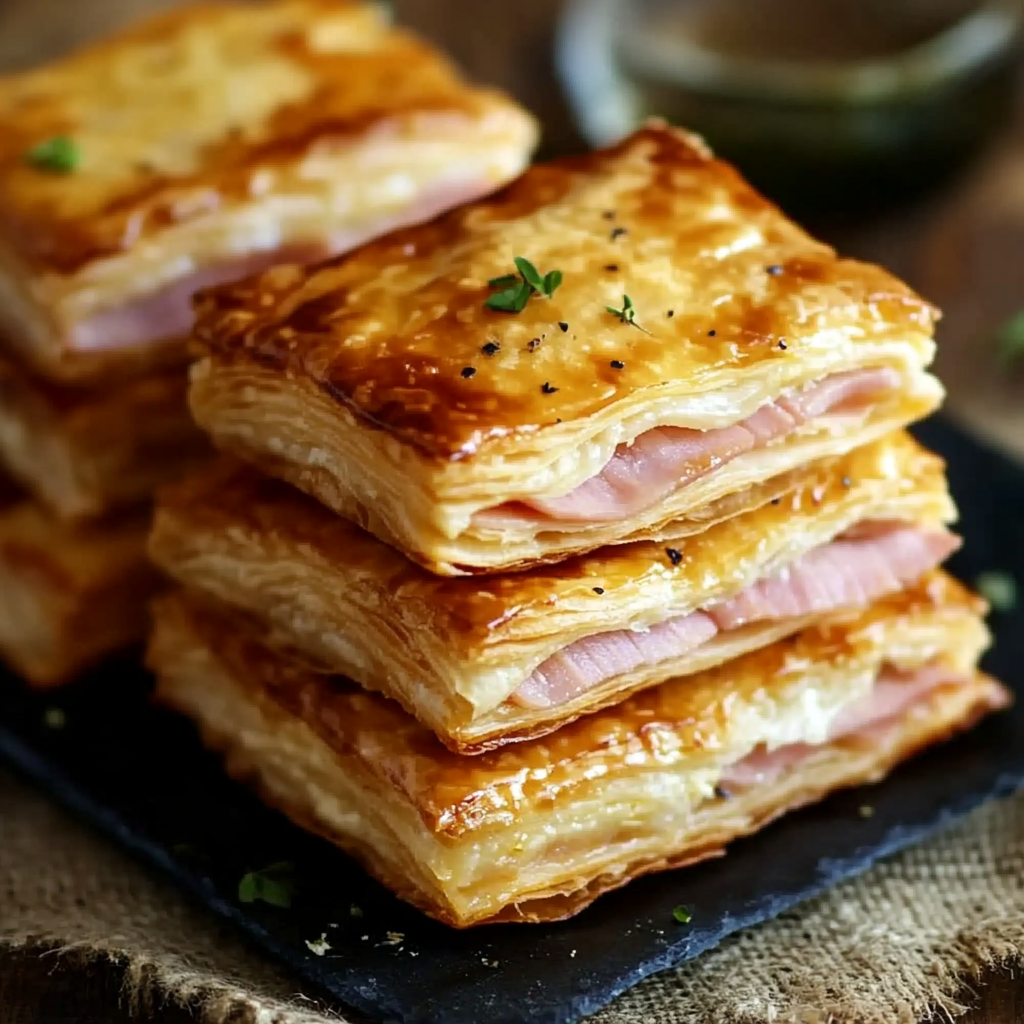
Variations on the Classic Recipe
While ham and cheese puff pastry pockets are a timeless favorite, there are many delicious ways to customize this recipe:
-
Spinach and Feta Pockets: Add sautéed spinach and crumbled feta for a Mediterranean twist.
-
Turkey and Swiss Cheese Pockets: Substitute ham with turkey and cheddar with Swiss for a lighter flavor.
-
Vegetarian Mushroom Pockets: Fill with caramelized onions and sautéed mushrooms for a hearty meat-free option.
-
Breakfast Sausage Pockets: Incorporate cooked breakfast sausage and scrambled eggs for a full meal in a bite.
For even more ideas, browse through curated Easy Puff Pastry Recipes on Pinterest. Understanding the Types of Cheese can also help you pick the best variety for new combinations.
These variations allow you to adapt the basic technique to different occasions, dietary preferences, and flavor profiles.
How to Create a Breakfast Pastry Platter Featuring These Pockets
To create a standout breakfast pastry platter, start by making a batch of ham and cheese puff pastry pockets. Surround these savory bites with complementary items like mini quiches, fruit skewers, and assorted muffins.
Use colorful fruits like strawberries, grapes, and orange slices to bring vibrancy to your platter. Including a variety of cheeses, selected from a detailed List of Cheeses, adds a touch of sophistication.
For creative inspiration, check these beautiful Breakfast Platter Presentation ideas, showcasing how to mix textures and colors for maximum visual impact.
Arrange items in sections, grouping savory pastries together and separating them from sweeter options. Offer small bowls of spreads like jams and honey to add flavor diversity. Remember, a well-balanced platter ensures there’s something for everyone, making your brunch unforgettable.
Storage and Reheating Instructions
Properly storing ham and cheese puff pastry pockets ensures they stay fresh and delicious. Let the pastries cool completely before transferring them to an airtight container.
-
Refrigeration: Store in the refrigerator for up to 3 days. Reheat in the oven at 350°F until warmed through.
-
Freezing: For longer storage, wrap individual pockets tightly in plastic wrap and freeze. They can be frozen for up to 2 months.
Avoid microwaving, as it can make the puff pastry soggy. Instead, reheat frozen pastries directly in a preheated oven for the best texture.
For detailed tips on freezing and reheating pastries, check out this Baking guide.
By following these storage methods, you can enjoy delicious puff pastry pockets anytime without sacrificing their signature flaky texture.
Nutrition Information
Each ham and cheese puff pastry pocket offers a satisfying mix of protein, fat, and carbohydrates. On average, one pocket contains:
-
Calories: 350–400
-
Protein: 15–18 grams
-
Fat: 22–25 grams
-
Carbohydrates: 20–24 grams
These values will vary based on specific brands of ingredients used. To create a lighter version, opt for turkey ham, low-fat cheddar cheese, and a reduced-fat puff pastry.
Understanding ingredient choices, as detailed on Ham (food), can help you tailor recipes to meet your dietary needs without compromising flavor.
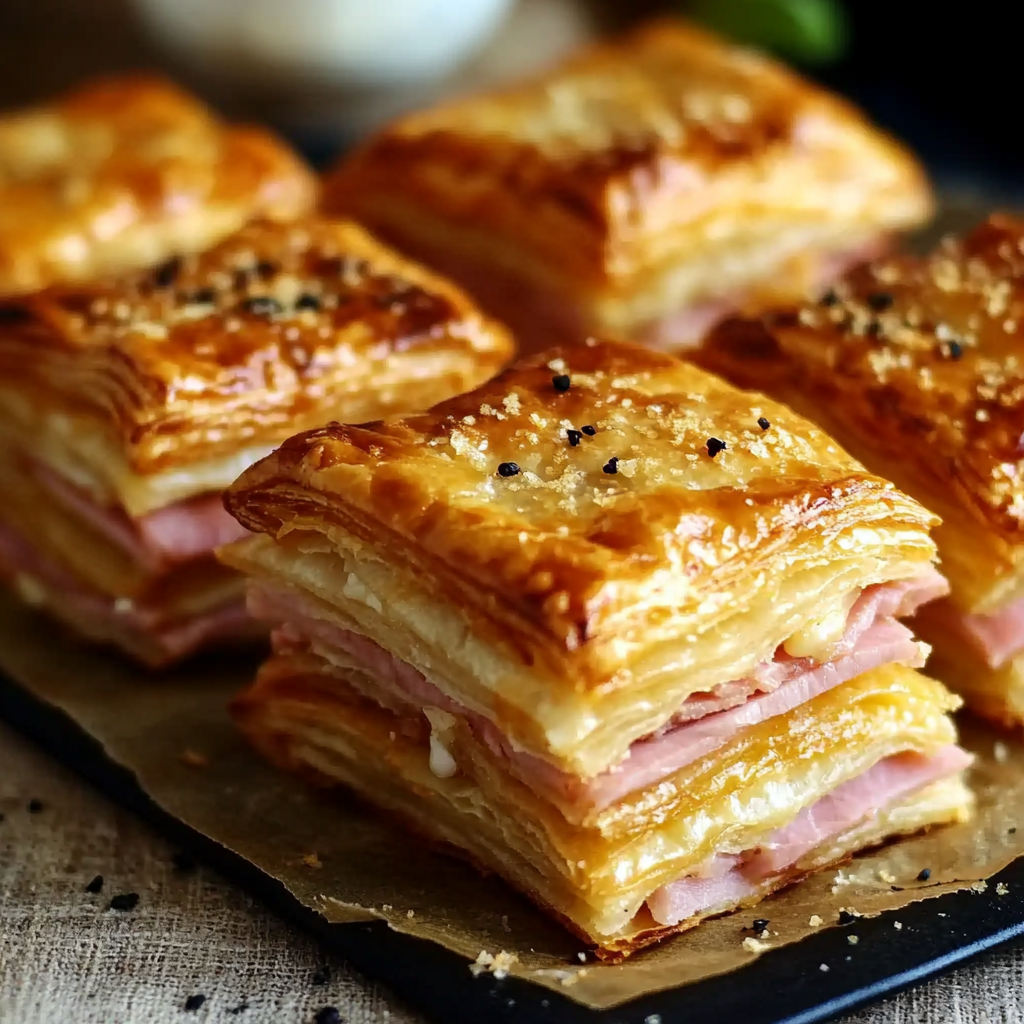
FAQs
Can you make puff pastry pockets ahead of time?
Yes, you can assemble puff pastry pockets up to a day ahead. Store them covered in the refrigerator and bake fresh when needed for the best results.
How do you keep puff pastry from getting soggy?
Prevent sogginess by avoiding overly wet fillings. Using an egg wash and baking on parchment paper also helps maintain a crispy crust.
What kind of ham is best for pastry pockets?
Choose quality deli-style ham, preferably lightly smoked, for the best flavor. Explore more types on Ham (food).
Can I freeze ham and cheese puff pastry pockets?
Absolutely. Freeze after assembly but before baking for best results. Reheat directly from frozen in a hot oven.
Can I use pre-made puff pastry sheets?
Yes, store-bought puff pastry sheets work perfectly for this recipe and save a lot of preparation time.
What other fillings can I put in puff pastry pockets?
You can experiment with turkey, spinach, mushrooms, or even sweet fillings like Nutella and bananas for dessert pockets.
PrintHam and Cheese Puff Pastry Pockets
Discover the ultimate breakfast pastry platter with this easy recipe for ham and cheese puff pastry pockets. These golden, flaky treats feature a savory filling of chicken ham and melty cheddar cheese, making them perfect for breakfast, brunch, or a satisfying snack. Quick to prepare and irresistibly delicious, this recipe is ideal for busy mornings or festive brunch gatherings.
- Author: Clara
Ingredients
- 1 sheet puff pastry, thawed
- 4 slices chicken ham
- 4 slices cheddar cheese
- 1 egg, beaten (for egg wash)
- 1 tablespoon Dijon mustard (optional)
Flour, for dusting the surface
Instructions
Preheat your oven to 400°F (200°C) and line a baking sheet with parchment paper.
Lightly flour your surface and roll out the puff pastry sheet slightly to smooth it out.
Cut the pastry into 4 equal squares.
If using, spread a thin layer of Dijon mustard on each square.
Place a slice of chicken ham and a slice of cheddar cheese on one half of each square.
Fold the other half of the pastry over the filling to form a triangle or rectangle. Press the edges with a fork to seal tightly.
Brush the tops with the beaten egg for a golden finish.
Bake for 15-18 minutes or until the pockets are puffed and golden brown.
Allow to cool for a few minutes before serving.
Notes
-
Make sure the puff pastry stays cold while working to ensure maximum puffiness.
-
Use parchment paper for even baking and easy cleanup.
-
Feel free to customize with different meats, cheeses, or vegetarian fillings.
-
Best served warm, but leftovers can be reheated in the oven.
-
Assemble the night before for an even quicker breakfast the next day.
